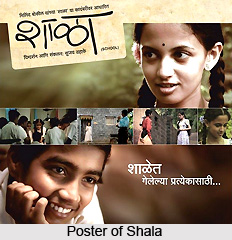 Marathi cinema or Marathi Chitrapat denotes the films produced in the Marathi language in the state of Maharashtra, India. It is the oldest and pioneer film industry in India. Many film historians would designate Maharashtra as the birthplace of Indian cinema. The name of Dadasaheb Phalke is honoured as the father of Indian cinema. Early on, there were a number of Marathi film directors who showed talent and commitment to the growth of Indian film culture. V.Shantaram, Damle, Fatehlal, Master Vinayak and also P.L. Deshpande, G.D. Madgulkar, Raja Paranjpe and Sudhir Phadke are perhaps most significant. However, as an art form and industry, it has its share of problems: most films made in Marathi are cheap and commercial often modelled on Hindi films and they cater to the escapist desires of the majority of audience. In terms of experience, style and technique, there is little to recommend them.
Marathi cinema or Marathi Chitrapat denotes the films produced in the Marathi language in the state of Maharashtra, India. It is the oldest and pioneer film industry in India. Many film historians would designate Maharashtra as the birthplace of Indian cinema. The name of Dadasaheb Phalke is honoured as the father of Indian cinema. Early on, there were a number of Marathi film directors who showed talent and commitment to the growth of Indian film culture. V.Shantaram, Damle, Fatehlal, Master Vinayak and also P.L. Deshpande, G.D. Madgulkar, Raja Paranjpe and Sudhir Phadke are perhaps most significant. However, as an art form and industry, it has its share of problems: most films made in Marathi are cheap and commercial often modelled on Hindi films and they cater to the escapist desires of the majority of audience. In terms of experience, style and technique, there is little to recommend them.However, despite this commercial film culture, a number of directors have recently sought to create a vibrant artistic cinema in Maharashtra, among them Jabhar Patel, Amol Palekar, Nachiket, Mahesh Manjrekar and Jayoo Patwardhan and Vijaya Mehta.
History of Marathi Cinema
Marathi Cinema is the earliest type of Indian cinema. In 1913, with the release of the first Indian film, Raja Harishchandra, Dadasaheb Phalke, renowned as the founder and pioneer of cinema in Pre-Independence India, imported the revolution of moving images to India. The film was created with full Marathi crew. In 1919 Baburao Painter established the Maharashtra Film Co. and Sairandhari in 1920. With the gradual development of the country, cinema in Maharashtra grew along with other places in India. Some of the most renowned films are discussed below-
Poona Par Hallo (1924)
Directed by Mama Warerkar, the film starred Miss Bhawani, Krishnarao Ketkar, Shankarrao Sahasrabuddhe, Vishnupant Pagnis, Miss Kaiser, and Sunderrao Nadkarni. The Maratha historical incident of Mughal Emperor Aurangzeb's attack on Pune and the ensuing battle with the Maratha hero Shivaji was portrayed in the movie. The film was often compared to Baburao Painter's Sinhagad, but the underlying message of independence was far stronger in this film. The director Warerkar was an important Marathi playwright as well, and this remains one of his best films.
For more, visit the link below: